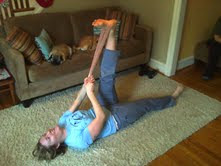

Ralph is a professor at UPenn who blows off steam playing squash three to five days per week. The stress relief from this activity is a must for him, but lately, he has been experiencing a nagging and uncomfortable pain on his right lower back, just to the side of his sacrum. The pain increases with the frequency of squash games and subsides with rest. It sounded muscular from his description, like the muscles in that area were in tight knots. I asked Ralph if he stretched and he said, "Well, a little bit." So I took that as a no!
In our work together, Ralph and I have mainly focused on strength-training, but we decided to start working on a few yoga postures that would target the affected area. The pictured pose, jathara parivartanasana, is a lying twist that opens the muscles on the outer hip (gluteals, IT Band), torso (rectus abdominis, internal and external oblique, erector spinae) and upper chest/shoulder (pectoralis major, anterior deltoid).
This pose is executed by lying down, bringing the arms to a "T," and pulling the knees all the way in to the chest. To twist, allow the legs to fall over to one side, hugging the thighs in towards the belly, and look to the opposite side. As you can see in the picture to the left, this pose creates open space from the left armpit to the left outer hip. As you look to the picture on the right, you can see that the right side of his body is tighter and his right shoulder has a harder time releasing down to the floor.
Like Ralph, other athletes who play racket sports may experience similar asymmetries due to their engagement in repetitive motion on one side of the torso. Jathara parivartasana, nicknamed "belly rolling twist," is a first step toward balancing the body.
I would suggest practicing this pose after each game or practice. Rather than holding for 30 seconds on each side, I suggest counting breaths on each side: 15 on the more open side, 30 on the tighter side. Breath in and out through the nose. On the inhale, breath into the outer hip, ribs and front shoulder. On the exhale, allow breath to leave the belly, both shoulders to soften to the floor, and the thighs to succumb to gravity.
**Tip: Though this is not shown, you can place a folded blanket or pillow underneath the arm for support if it is dangling in the air.





